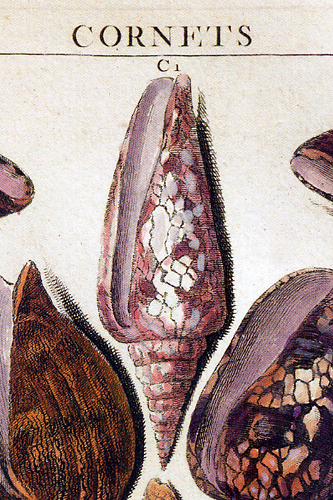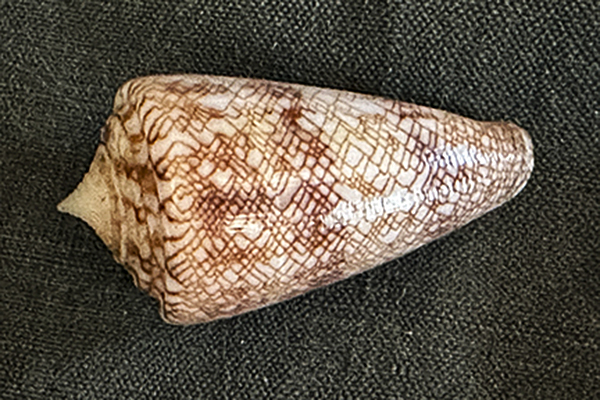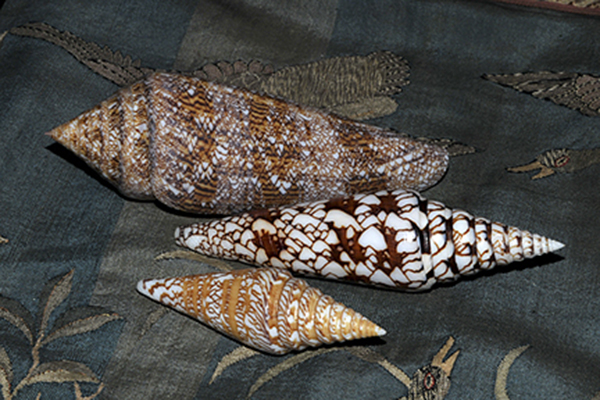The "Glory" Cone Shells

With more than 500 species, Conus is the largest genus of marine invertebrates, and for two hundred years Conus gloriamaris, Chemnitz 1777 ("Glory of the Sea") was the most rare and desirable of them all. But it is only one of several cone shells that, because of their beauty and relative rarity, have been considered the "glory" of where they are found.
Conus granulatus, Linnaeus 1758 ("Glory of the Atlantic") was the first of the glorious cones to be described, its name deriving from the granulations of the body whorl. Rumphius illustrated the shell (Voluta maculosa granulata) in 1711 in his Thesaurus imaginum piscium testaceorum (Tab. XXXII, Fig. T). And, in 1758, Linnaeus remarked on its red and purple coloring in Systema Naturae (10th ed., Vol. I, p. 716 [274]), although he was mistaken in citing its locality as O. Africano. Considered rare even by 1825, it easily is the equal in price to any of the other shells pictured above. The species occurs in the tropical waters of the western Atlantic, from south Florida to the West Indies. Although the shell can grow to approximately 61 mm, most specimens are less than 40 mm. The one illustrated is only 26 mm, although the color is quite vivid. The holotype is in the collection of the Linnean Society (London).
Conus milneedwardsi, Jousseaume 1894 ("Glory of India") was named after Alphonse Milne-Edwards (1835–1900, Director of the Paris Museum of Natural History) and described by Melvill and Standen in 1899 as C. clystospira ("illustrious spire," a more descriptive name from the Greek). The authors enthused that it "undeniably constitutes one of the most important discoveries of the kind during the nineteenth century. It will rank amongst the most select of a genus unusually distinguished in both form, texture, and coloration....The spire, however, is the most distinguishing characteristic."
The next year, and with no less enthusiasm, Melvill declared that "The discovery of this marvellous species, one of the most select not only of all Coni but of all marine molluscs, is sufficient to mark an epoch" and suggested that "this new species (C. clytospira) form a separate section by itself." He also described how it had been found. Three specimens had adhered to the pitch coating of an undersea telegraph cable, the largest one lost as the cable was being hauled up. Only later was it realized that C. milneedwardsi had been minutely described in Latin by Jousseaume five years before.

Indeed, a Mme. Bandeville had purchased one for her collection in 1749, and allowed it to be illustrated in the third edition of La Conchyliologie (1780) by Antoine-Joseph Dezallier d'Argenville, where the shell of extrême rareté is named Le Drap d'Or Pyramidal ("Cloth-of-Gold Pyramid") (Vol. II, pp. 645–647; Plate XVIII).
When Dance wrote in 1966, fewer than a dozen examples of C. milneedwardsi had been discovered. The shell ranges along the east coast of Africa from Natal to the Red Sea and varies in size between 60 and 174 mm; the one illustrated above is 110 mm. The holotype is in the National d'Histoire Naturelle Muséum (Paris).
C. bengalensis, Okutani 1968 ("Glory of Bengal") is similar to C. milneedwardsi but larger and with a lower spire. It is found in the Bay of Bengal (and the Red Sea) and ranges in size from 85–132 mm; the one illustrated is 107mm. The holotype had been trawled ten years earlier by a Japanese research vessel and now is in the Tokai Regional Fishery Research Laboratory (Tokyo).

Conus glorioceanus, Poppe & Gagaro 2009 ("Glory of the Ocean") is the last of the "glory" cones to have been discovered, 250 years after C. granulatus was described. Named after its similarity to C. gloriamaris (although in size and shape, it is more like C. ammiralis), the shell was found off the southern shore of Mindanao in the Philippines. The one illustrated is 38 mm, which is typical of the size. The holotype, which measures 49 mm, is in the National Museum of the Philippines (Manila).

"Three cones are remarkable for the height of their spires, for their striking markings, and for their scarcity: Conus gloriamaris, C. milneedwardsi, and C. excelsus. The first of these is the best known and is now much the easiest to acquire; the second is currently regarded by many as the most desirable of all the cones; but the third—scarcest of the three and no less beautiful—is not widely known to collectors....A freshly-collected specimen must be a lovely object."
Dance, Rare Shells (p.11
Conus excelsus, Sowerby III 1908 ("Illustrious Cone") first was described by Sowerby himself. "This magnificent shell, at present unique, defies comparison with any hitherto known species. The most prominent feature is the extraordinary height of its acutely conical spire, which is quite symmetrical....In colour it is rather light fulvous yellow, with white patches of various sizes and shapes, outlined with reddish brown." Another specimen was not recorded until 1945, "its colouration distinctive of golden yellow finely streaked with fine rosy axially vermiculate lines," years after it had been collected. And only one other shell was thought to have been found when Dance published his book in 1969. Size varies between 60 and 102 mm; the one illustrated is 72 mm and the holotype, 88.5 mm, which is in the British Museum. It had come from New Caledonia, off the northeastern coast of Australia, although it now is known to range as far north as Japan.
The first iconography to illustrate previously unfigured shells was Neues systematisches Conchylien-Cabinet, the initial three volumes of which were published by Martini in 1769. When he died, this monumental work, which extended over a quarter of a century to eleven volumes, was continued by Chemnitz, who produced the last eight. The intention was to portray every shell known and any newly discovered species, a seemingly impossible task then as now.
The nomenclature that Linnaeus had introduced more than a decade earlier was not used, however; and many of the illustrations were appropriated by others who simply attached binominal names to them, claiming authorship of the species for themselves. C. gloriamaris is the only species to carry the name of Chemnitz as author, and this was because he had published a separate description that year.
References: Shell Collecting: An Illustrated History (1966) by S. Peter Dance; Rare Shells (1969) by S. Peter Dance; Manual of the Living Conidae (1995) by Dieter Röckel, Werner Korn, and Alan J. Kohn; "Description of Conus (Cylinder) clytospira sp. n., from the Arabian Sea" (1899) by James Cosmo Melvill and Robert Standen, The Annals and Magazine of Natural History, 4(7), 461-493; "Note on Conus clytospira Melv. and Stand." (1899-1900), The Manchester Literary & Philosophical Society, XLIV, pp. x-xi;"LXXIII—Description of a New Species of the Genus Conus" (1908) by G. B. Sowerby [III], The Annals and Magazine of Natural History, 1(6), 465-466; "A Catalogue of the Cone Shells (Conidae) in the South Australian Museum: Asprella Tannaensis" (1945) by Bernard C. Cotton, Records of the South Australian Museum, 8(2), 270; "Von einer ausserordentlich seltenen Art Walzenförmiger Tuten oder Kegelschnekken, welche den Namen Gloria maris führet (1777) by J. H. Chemnitz, Beschäftigungen der Berlinischen Gesellschaft Naturforschender Freunde, 3, 321-331; "Notes on J. H. Chemnitz," (1994) by Peter Reichert, Hawaiian Shell News, 42(11), 1, 4-5; Antoine-Joseph Dezallier d'Argenville: Shells (2009) by Veronica Carpita, Rainer Willmann, and Sophia Willmann; The Conus Biodiversity Website (Alan J. Kohn, Principal Investigator), which updates and corrects the description of the Indo-Pacific cones from the Manual of the Living Conidae, now out of print; Linnaeus: Systema naturae (1758), 10th ed. (p. 716, no. 274); "A New Cone from the Bay of Bengal, Darioconus bengalensis, n. sp." (1968) by Takashi Okutani, Venus, 26(3-4), 66-70; "Type Specimens and Identity of the Described Species of Conus.1: The Species Described by Linnaeus, 1758-1767" (1963) by Alan J. Kohn, Journal of the Linnean Society (Zoology), 44, 740-768; "A Historical Review of the Mollusks of Linnaeus. Part 2. The Class Cephalopoda and the Genera Conus and Cypraea of the Class Gastropoda" (1953) by Henry Dodge, Bulletin of the American Museum of Natural History, 103(Art.1), 1-134; "A Spectacular New Conus (Conidae) from the Philippines" (2009) by G. T. Poppe and S. P. Tagaro, Visaya, 2(4), 52-56; "Diagnose des Coquilles de Nouveaux Mollusques" (1894) by d'Jousseaume, Bulletin de la Société Philomathique de Paris, 8(6), 98-105.